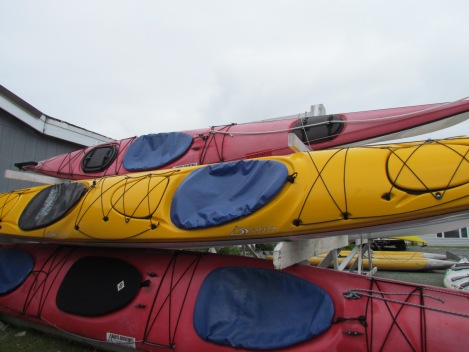According to Poets.org, an abecedarian writing form is one in which “each line or stanza begins with the first letter of the alphabet and is followed by the successive letter, until the final letter is reached.” Used more often in poetry, it can also be used in prose. In 2012, at a writers retreat in Tutka Bay, Alaska, we were given a writing assignment by author Pam Houston to write an story in the abecedarian form – either A to Z or Z to A. We were given the reprieve to leave off either X or Z but not both letters. Other rules:
- One sentence must be one word long.
- One sentence must be 100 words or more long.
Here is the essay I wrote. I thought of it as I embark on my first sea-kayaking trip this month in Baja.
Kayaking, First Time
Zig-zagging across white-foam rapids, the kayakers commanded their vessels and the waters before them, and in an instant, I knew I wanted to kayak.
You’d think a city girl with limited athletic prowess and a questionable ability to swim might pick some more terrestrial pursuit, but I was convinced I was going to spend the rest of my life in a kayak.
World travel had always been my dream, my life’s goal, so why not do it from one body of water to the next, to hell with my fears?
Very few things scare me more than the things that might lurk below dark waters, an irrational fear left over from reading the only Stephen King story I’d ever dared to read, and yet the idea of being safely ensconced in a kayak with few possessions appealed to me like never before.
Until I was at kayak lessons in Salina, Colorado, I don’t think I was quite sure if my dream of kayaking would be anything more than a relentless yearning.
The fact that the lessons took place in a pool settled my panic momentarily.
Smiling, the hefty kayaking instructor led me through the lesson that, he explained, would include tipping me upside down while skirted to the kayak.
“Really, it’s not as bad as it seems,” he assured me, and I was less assured by his words and more by the fact that he looked big enough to right the kayak with ease.
Quietly, I went through the steps of attaching myself into the kayak, fingering the string that I would pull to release myself from its womb.
“Please don’t let this be like that scene in ‘An Officer in a Gentleman,’” I thought, entirely to myself, not wanting to replay the part of the movie in my head that haunted me the most: during the training when that one guy was in the chair contraption that was dropped into the swimming pool, sinking to the bottom, and he had to unbuckle himself from the chair while totally submerged but panicked, took in water, and the Richard Gere character dove in to unbuckle him and pull him up, out of the pool, and he was blue and practically, almost dead.
“Okay, I can do this,” I said aloud, but no sound came out.
“No biggie if you don’t want to do this,” said the instructor.
My fears were not going to interfere with my dream.
“Lot’s of people do this,” I told myself in my head, “and they don’t die.”
Kayaking would lead me to places I’d never been, to experience something closer to adventure in my life than the easy RVing I’d been doing for almost a year.
Just as I pictured the first exotic place I’d go with a shiny red kayak, I was upside down.
I was under water.
How did this happen?
God, help me.
Fuck.
Ever have the feeling that you’re going to die, and it is really just a ridiculous thought in that abyss of the unknown.
Dying at this moment was a certainty.
Couldn’t he tell I was banging on the kayak bottom, the signal that I needed help?
Bad idea, this was such a bad idea, I thought, as I resigned myself to taking in my first – and last – deep breath of water.
And then he tipped me back over.

